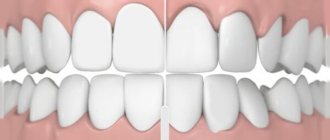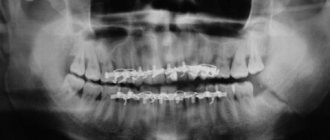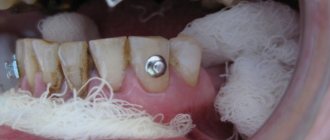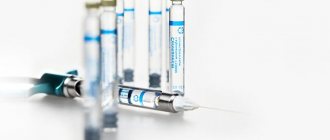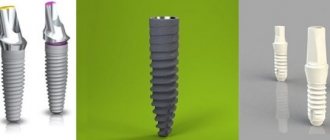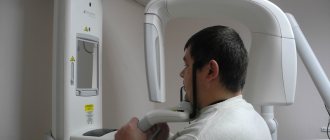Any injury to the bones of the skull is extremely dangerous. The jaw is most often affected; young men aged 18 to 40 are at risk. Fractures of the upper and lower jaw require serious and immediate treatment
, so it is very important to contact a specialist in time.
Main causes of jaw fracture
Such pathologies arise under the influence of mechanical stress on the bone, the force of which exceeds its strength. Most often, fractures of the maxillofacial region (MFA) occur in the following cases:
- Road traffic accidents.
- Extreme sports.
- Pronounced physical impact.
- Firearms.
Not everyone who finds themselves in such unpleasant situations suffers a broken jaw. The skull bones are very strong, so the incident must be really serious. True, there are people who are more susceptible to non-gunshot fractures of the lower and upper jaw than others.
If the following conditions are present, the bones of the skull break more often and more easily:
- Oncological diseases.
- Inflammatory processes in bone tissue.
- Infectious diseases, especially tuberculosis.
- Taking certain medications.
- Impaired bone mineralization.
- Metabolism problems.
- Acute deficiency of vitamins and microelements.
Diagnostics
The fracture is diagnosed by an oral and maxillofacial surgeon. An x-ray may show different degrees of damage:
- partial damage - damage to part of the bone, not complete detachment;
- non-displaced fracture – damage to all parts of the bone;
- complete fracture - the x-ray shows a gap between the separated part and the skull;
- fracture in different places - damage to the alveolar process in different places, bone fragmentation;
- fracture with deformation - a completely torn off part, displaced at a different angle.
Symptoms of a jaw fracture
A bone fracture is always painful, so it is impossible not to notice it. And yet, people sometimes confuse the signs of a jaw fracture and a dislocation and, not realizing the seriousness of the situation, try to solve the problem at home. To correctly identify an injury, you need to know its main symptoms:
- Pain that intensifies when touching the chin and any movement of the jaw.
- Unnatural bone mobility.
- Malocclusion. In many cases, a person cannot close his jaw at all.
- Photo: spaces between teeth due to a jaw fracture
Gaps almost always form in the dentition.
- In most cases, teeth break or fall out.
- Changes in the relief of bones, especially in the chin area. The injury noticeably displaces him.
- Hematomas and bruises appear on the face and in the oral cavity.
- Increased salivation.
- Recession of the tongue.
- In most cases, the patient is completely unable to speak, eat or move his jaw normally.
- General malaise occurs. The patient suffers from headache and dizziness. Sometimes the temperature rises and drowsiness appears.
All these symptoms can be considered general. They are typical for any type of similar injury, but there are also narrower signs on which the classification of fractures of the lower and upper jaw depends.
How long will it take for the injury to heal?
When asked how long it takes for a jaw fracture to heal, doctors answer that on average rehabilitation lasts up to 3 months. The trauma is significant, and only after the first month of treatment do patients begin to feel relief. Much of the relief is due to the fact that 21 days after the operation the fragments heal and doctors remove the splint, but sometimes this happens later, only on days 30–40.
On average, rehabilitation lasts up to 3 months
If you do not follow the doctor’s recommendations, in case of chronic diseases that disrupt tissue trophism (for example, diabetes), the healing process may take 2–4 weeks longer.
“I suffered a broken jaw in an accident. How many tears I shed while being treated!!! This whole thing heals quite slowly, you have to wear a splint, and it’s generally difficult to eat normally. If you want to lose weight and get rid of extra pounds, break your jaw. Black humor! This splint also constantly rubbed the mucous membrane on the cheeks and lips. All this time there was pain. After the splint was removed, there were sores and inflammation in my mouth. Then she replaced the teeth, since some were knocked out during the accident. In total, it took six months to recover. Now, thank God, the pain is gone, but it pulls and aches for any reason, for example, if the weather changes...”
Mi, fragment of review from otzovik.com
Classification of jaw fractures
Experts distinguish more than a dozen different types of fractures, and the treatment of the patient depends entirely on whether the injury belongs to one type or another. First of all, fractures of the lower and upper jaw can be distinguished, but these groups are also divided into several smaller ones depending on a number of signs.
Types of jaw fractures by severity of injury
- Closed fracture. It damages the bone, but the surrounding soft tissue remains intact. This type of pathology is less dangerous, since the treatment lasts relatively short. A non-gunshot closed fracture of the lower jaw heals without complications in 3–4 weeks.
- Open fracture. Bone fragments can move to the side and damage soft tissues, blood vessels and joints. This pathology can be recognized by severe bleeding. Open fractures of the lower jaw are more common.
An open injury is doubly dangerous, since it carries a high risk of bacterial infection and severe blood loss. Medical assistance must be provided immediately.
Types of jaw fractures based on displacement of fragments
- Fracture without displacement. With such an injury, the bone can even be divided into multiple fragments, but they are in a standard position and do not move relative to each other. The crack may be incomplete. Injury is easier to treat and carries with it minimal consequences.
- Displaced fracture. In this case, the jaw fragments change their position, which causes additional pain and complicates treatment. With open injuries, the bone is always displaced.
A displaced fracture of the lower jaw is more common than the same injury to the upper part of the skull. Damage can be recognized by severe swelling and facial asymmetry. - Comminuted fracture. The bone splits into separate fragments of different sizes, which are arranged in a chaotic manner. In most cases, the pathology is accompanied by damage to soft tissues and requires immediate medical attention and long-term treatment. Often, after hospitalization, patients also have to see a plastic surgeon.
Types of jaw fractures by location of injury
The types of fractures of the lower and upper jaw are determined not only by symptoms, but also by location:
- A midline fracture is located in the middle of the bone.
- If the injury is located near the lateral incisors, it is defined as incisive.
- A canine fracture is an injury to the third teeth of the upper or lower jaw.
- A crack in the chin area is designated as mental. It is one of the most common jaw injuries due to the fact that a person's chin protrudes noticeably.
- An angular fracture can only occur in the lower jaw. It is located in the corners of this bone, closer to the base of the skull.
Doctors may use a more extensive classification of such injuries. It’s even difficult to imagine exactly how many types of pathology there are - each case is individual in its own way.
Rubber bands for splinting
In some cases, splinting with wire requires additional fastening with special rubber bands to fix the jaws in a closed state. The main purpose of the rubber bands is to move the teeth in the direction in which they were originally. There are many advantages of elastic material:
- The rubber bands are easy to cut and remove, which is especially important if the patient has suffered a head injury and there is a risk of complications in the form of epileptic seizures, fainting and other neurological disorders.
- With the correct tension, the elastic bands allow you to take food through a tube; a tighter fastening often leads to tube feeding.
- Damaged rubber bands can be easily replaced, while damage to the metal structure will require serious medical intervention.
The decision to install rubber bands for splinting must be made by a doctor and most often they begin to be used only when primary healing of the injured jaw has occurred. In the first stages, as a rule, more rigid fixation is required. In any case, consultation with a specialist is required, who, based on the condition of the teeth, the nature of the damage, and the general condition of the patient, will be able to determine the most suitable type of splinting. Dr. Sadov’s clinic in Moscow employs professionals who have completed internships abroad and clearly understand the specifics of dental orthopedics.
First aid for a broken jaw
The very first thing to do if a person breaks their jaw is to call an ambulance. After this, measures can be taken to alleviate the victim’s condition:
- Since damage most often occurs in the event of an accident, fights, or falls, first of all you need to make sure that the person’s life is not in danger.
- If there are several non-gunshot injuries, the jaw should be addressed first. The exception is open fractures of other bones if the head injury is closed.
- If there is bleeding, apply a clean, preferably sterile, cloth to the wound. If the damage is minor, cotton wool will do.
- If the patient is unconscious, carefully turn him on his side. Clear your mouth of blood clots and vomit. This must be done extremely carefully, wrapping your finger in a clean cloth.
- Then you should put the patient in a comfortable position and try not to move him anymore. If the patient is conscious, a sling-shaped bandage is applied to the broken jaw, as in the photo on the right.
- Ice is applied to reduce pain. If possible, it is worth giving the victim painkillers. In this case, an intramuscular injection will be most effective. Analgin, Naproxen, Revalgin are suitable tablets.
Since the patient is unable to swallow, the painkiller tablet must be crushed and dissolved in water. If the person is unconscious, you can pump the liquid into a syringe without a needle and gently pour the medicine directly down the throat.
Treatment of a jaw fracture
Splinting
Once the patient is admitted to the hospital, he is sent for an x-ray to find out if the jaw is broken and to determine the exact location and severity of the injury. The stages of treatment depend on the classification of the fracture. In most cases, splinting will be done, but additional therapies may be prescribed.
A special plastic device or wire structure is placed on the jaw on the damaged side. In case of injury on both sides of the bone, a more complex and rigid product is used. After installing the structure, a series of loops are formed in the smile area. The hooks on the upper and lower jaws are connected by elastic bands.
The main task of splinting is to maintain the immobility of bone tissue for exactly as long as the jaw fracture heals. Treatment usually lasts from 3 weeks to six months.
For displaced angular injuries, a bone suture is required.
To do this, the crack is exposed from soft tissue, and small holes are made in the bone fragments along the entire length of the fracture. Then the parts are connected to each other with a special wire and covered with soft cloth.
After the main operation, rehabilitation begins. For faster tissue regeneration, magnetic therapy, ultraviolet irradiation, calcium electrophoresis at the fracture site, or other therapeutic procedures are used.
Treatment of a jaw fracture at home
After 3–4 weeks, if the fracture is uncomplicated and the person is no longer in danger, he can be discharged from the hospital.
Usually by this time the bone has not completely healed, so the specialist gives a number of recommendations for continuing treatment at home:
- For an open fracture of the jaw, antibiotics are prescribed; after discharge from the hospital, you need to continue taking them at home.
- To speed up healing, multivitamin complexes rich in calcium and substances that improve its absorption are prescribed.
- You can treat a crack in the jaw with folk remedies, but before using them you need to consult a doctor. Most of all, experts approve of paraffin therapy.
- After removing the splint, you will have to wear a special fixing bandage for several months - first it is worn all day, and then only at night.
- If the splint has already been removed, the jaw needs to be developed. Every day for a few minutes a person should do simple exercises: move his jaw from side to side, open and close his mouth wide.
All of the recommendations listed can only be used as a supplement to the main treatment that takes place in the hospital. It is impossible to cure a fracture without medical help.
Nutrition for a jaw fracture
Due to the injury, the process of eating becomes more difficult, because it hurts the patient to even open his mouth, not to mention chewing. And yet a person must receive a sufficient amount of nutrients. This determines how long it will take for a crack in the jaw to heal. If there is a deficiency of nutrients, the treatment period increases and more complications appear, so the patient is fed according to certain rules:
- A rubber tube is inserted directly into the patient's throat, through which a nutrient solution or liquid food will be administered. Usually the tube is placed through an area where one or more teeth are missing, which happens quite often when the skull bones are damaged. If there is no gap, then the tube is placed in the mouth through the gap after the wisdom tooth. Such nutrition is convenient because it is possible even at home.
- If a patient with a jaw fracture is in intensive care, doctors make droppers with a special solution rich in nutrients, vitamins and minerals. If this is not possible, a nutritional enema is used.
- The basis of the diet is ground meat mixed with milk or broth, baby food, pureed soups, fruit and vegetable dishes, and liquid porridges.
- The patient will need more calories than he normally needs. In addition, the vitamin and mineral value of the diet increases.
What needs to be done during the rehabilitation period?
- After the operation, it is allowed to eat exclusively liquid food and broths: it is recommended to eat food through a straw. Later, when the splint is removed (after about 21 days), you are allowed to eat food that has been blended and has a pureed consistency, as well as ground meat. A gentle diet must be followed for at least another month from the moment the tires are removed,
- you cannot open your mouth and strain your jaw: you will have to say “no” to meeting friends, communicating with colleagues, talking and laughing,
- it is necessary to follow the recommendations of doctors and take prescribed medications and drugs,
- It is important to undergo a course of physiotherapy procedures that promote accelerated tissue restoration: they can be carried out no earlier than 3–5 days after surgery. This could be magnetic therapy, electrophoresis,
- physical therapy: it is done after removing the fixing splints,
- undergoing routine examinations: they are carried out at least once a week until complete recovery.
Do not open your mouth or load your jaw
Consequences of a jaw fracture
Such a complex injury cannot go away without a trace; even with proper treatment, certain complications are present:
- Deformation of facial features. Asymmetry arises, sometimes very noticeable (see photo). Typically, this consequence occurs when the jaw is fractured with displacement. With less dangerous pathologies, such a change is almost imperceptible.
- Loss of teeth and their curvature. In many cases, gaps form between the teeth and the bite is disrupted.
- The remaining teeth may become loose when chewing, most often this phenomenon occurs after an angular fracture.
- The vast majority of patients experience jaw crunching after treatment for a fracture. Moreover, this can last until the end of life.
- Due to liquid nutrition, problems with the gastrointestinal tract arise.
You need to understand that a head injury is always dangerous. Only correct and timely medical care will reduce the number of consequences to a minimum.
How to take care of your mouth and brush your teeth while wearing a splint?
Often patients are given a splint that tightens the upper and lower rows of teeth. Therefore, difficulties arise with daily care of teeth and gums. However, it is necessary to maintain hygiene, because a number of studies1 show that after wearing splints, many patients experience periodontal inflammation, as well as caries if hygiene was lacking.
Hygiene can be carried out using antiseptics and rinses that are used to rinse the mouth. To clean teeth and dental structures, you need to buy a brush with soft bristles and a brush. It is also recommended to purchase an irrigator that will help thoroughly rinse the mouth from food debris. True, you can use it no earlier than 10 days after the operation, and only on the most gentle regimen. It is necessary to rinse and irrigate up to 8–10 times a day.


